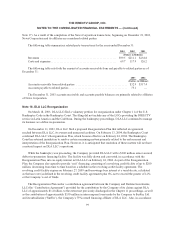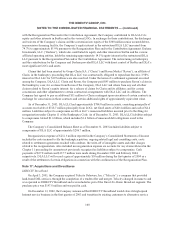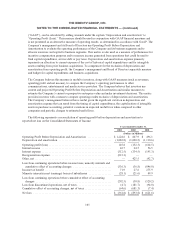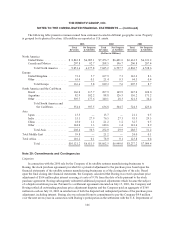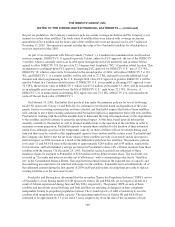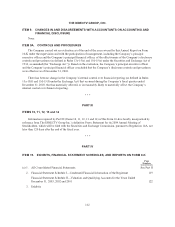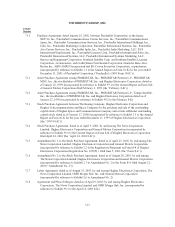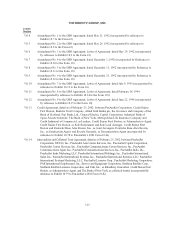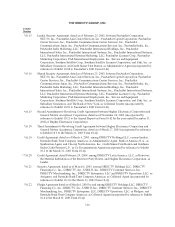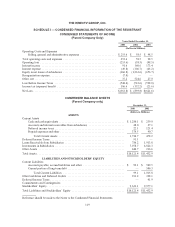DIRECTV 2003 Annual Report Download - page 116
Download and view the complete annual report
Please find page 116 of the 2003 DIRECTV annual report below. You can navigate through the pages in the report by either clicking on the pages listed below, or by using the keyword search tool below to find specific information within the annual report.THE DIRECTV GROUP, INC.
NOTES TO THE CONSOLIDATED FINANCIAL STATEMENTS — (continued)
satellite’s anomaly, based on the bi-propellant fuel on-board. Accordingly, PanAmSat began accelerating
depreciation of these satellites beginning in the third quarter of 2003 to coincide with the satellites’ revised
estimated useful lives. The additional depreciation expense resulting from this change in estimated useful lives
was $14.3 million in the second half of 2003.
PanAmSat has determined that the net book value of these satellites and its investments in sales-type leases
on these two satellites are fully recoverable. On July 31, 2003, PanAmSat filed a proof of loss under the
insurance policy for Galaxy 4R in the amount of $169 million, subject to a salvage provision providing for
PanAmSat to share a portion of the revenues with the insurers. During the third quarter of 2003, PanAmSat
reached an agreement with all but one of the insurers representing, in the aggregate, approximately 83% of the
insurance coverage on the satellite. As a result, in the third quarter of 2003, PanAmSat recorded an insurance
claim receivable of $102.6 million reflecting the insurance policy amount for these insurers less a negotiated
settlement for salvage. PanAmSat received these proceeds during the fourth quarter of 2003. PanAmSat
proportionately offset the proceeds from this settlement against the insured carrying value of the satellite and the
net investment in sales-type lease. In October 2003, PanAmSat commenced arbitration proceedings against the
last insurance provider over a disputed portion of the remaining claim. PanAmSat cannot provide assurance that
it will be successful in these proceedings or, if successful, how much will be received. PanAmSat is developing
plans to replace Galaxy 4R prior to the end of its useful life using anticipated insurance proceeds and a spare
launch service contract that was purchased previously. Once a settlement is reached with the final insurance
provider, PanAmSat anticipates that future depreciation on Galaxy 4R will be approximately equal to the
depreciation on this satellite before the anomaly occurred. The insurance policy on PAS-6B has an exclusion for
XIPS-related anomalies and, accordingly, this was not an insured loss. PanAmSat is working with the customers
on PAS-6B to provide a long-term solution for their needs.
The availability and use of any future proceeds from the Galaxy 11 and PAS-1R insurance claims are
restricted by the agreements governing PanAmSat’s debt obligations.
PanAmSat believes that the XIPS problem will not affect revenues over the revised estimated remaining
useful lives of Galaxy 4R and PAS-6B. Prior to the end of the useful lives of these two satellites, PanAmSat
plans to transition the affected customers to new or existing in-orbit backup satellites with immediately available
capacity. As a result of the XIPS failure on PAS-6B, PanAmSat reduced its total backlog by approximately $360
million, as the customers on this satellite are not contractually obligated to use a new or replacement satellite.
One of PanAmSat’s remaining five Boeing model 601 HP satellites has no book value and is no longer in
primary customer service. The other four Boeing model 601 HP satellites that PanAmSat operates continue to
have XIPS as their primary propulsion system. However, no assurance can be given that PanAmSat will not have
further XIPS failures that result in shortened satellite lives or that such failures will be insured if they occur. For
three of these remaining four satellites, the available bi-propellant life ranges from at least 3.4 years to as much
as 7.0 years, while the fourth satellite, which was placed into service in January 2004, has available bi-propellant
life of approximately 11.9 years.
In the first quarter of 2003, PanAmSat and the manufacturer of the Galaxy 8-iR satellite terminated the
Galaxy 8-iR satellite construction contract by mutual agreement. In connection with the termination of the
construction contract, PanAmSat received $69.5 million from the satellite manufacturer in December 2003,
which represents amounts previously paid to the manufacturer (of approximately $58.8 million), liquidated
damages and interest owed to PanAmSat under the construction agreement. In addition, PanAmSat has agreed
with the Galaxy 8-iR launch vehicle provider to defer the use of the launch to a future satellite. PanAmSat
expects to use this launch in early 2006 to replace the Galaxy 4R satellite.
109


